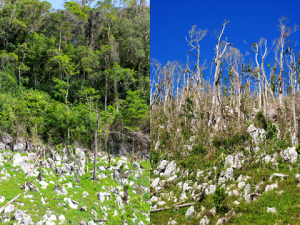CLIMATE CHANGE ADAPTATION – OUR NEW STRATEGIC PARADIGM
According to the Global Climate Risk Index 2017, Haiti was on top of the list of countries most affected by extreme weather in 2016. That year, “Haiti was hit by the most violent cyclone for more than 50 years and ranks first among the most affected countries.” According to the Germanwatch’s Global Climate Risk Index, Honduras, Myanmar and Haiti were the most affected by extreme weather events between 1996 and 2015. Hurricane Matthew, which raged in October 2016, destroyed a quarter of Haiti and reminded us that with climate change, cyclones will be more intense. Hurricane Irma was the most powerful storm recorded in the North Atlantic since Allen in 1980, with sustained wind speeds of 295 km/hr, yet another sign of climate change. The vulnerability of Haiti is no longer to demonstrate: it is now time to take action.
Biodiversity and adaptation to climate change are tangibly inseparable and are also factors of development. Biodiversity can play a role in reducing the effects and severity of climate change. Endowed with the evolutionary capacity to adapt, the myriad life forms on earth provide the foundation for ecosystem services that all humans need and some take for granted. For example, clean air and water. While all the attention is focused on the climate, it is somewhat puzzling to note that biodiversity seems reduced to the role of an indicator in the fight against climate change.
Let us recall three facts. First, as we enter the sixth major extinction crisis, climate change increases the risk of extinction by 40%. Second, the entire biodiversity of the world is changing. However, all biodiversity is important because it provides a set of ecological functions. Third, the first threat of biodiversity being agriculture, preserving biodiversity means changing our relationship to agriculture.
A climate context that does not spare the private sector
Société Audubon Haïti’s (SAH) mission is to conserve Haiti’s biodiversity and natural ecosystems through research, education, awareness and national / international partnerships. It’s mission is to help Haitian citizens improve their quality of life by conserving the natural areas of the island. Aware of the role that it can and must play in adapting to climate change, SAH wishes to invest in climate change-adapted strategies of which we are already victims.
Firstly, it is important that the issue of biodiversity and climate change be addressed in a cross-cutting manner and that the results be disseminated to the general public. In addition, climate change has a significant impact on the socio-economic development of countries, and climate change adaptation efforts must be part of a more resilient development vision. This vision cannot be achieved without the commitment of all stakeholders, especially those in the private sector. Indeed, according to the experts, it is largely private sector decisions that will determine the success of countries in the area of adaptation.
Thus, in this fight, everyone is an actor and SAH wishes to become a vital one. Indeed, until now, it is mainly the role of the public sector that has focused attention in adapting to climate change, with the private sector being mainly considered as a source of financing and investment. Yet, private sector engagement is critical for many reasons: it can mobilize financial resources and technical capacity, assist government efforts, organize civil society and community efforts, and develop innovative adaptation technologies. Private entities dominate many investments that are critical to adaptation, such as the location and design of buildings and other infrastructure investments.
In adapting to climate change, dialogue and knowledge-sharing must be fostered in order to facilitate the inclusive formulation of practical solutions and the most appropriate policies for resilient development. However, one of the observations made by SAH is that, in Haiti, this adaptation has almost no private sector players in its composition. With this in mind, SAH has decided to broaden its mission to adapt its communication policy and to develop new innovative projects that can, among other things:
1. Unite new behavioral changes of the various actors in Haitian society, as much about biodiversity conservation as about climate change;
2. Encourage the Ministry of the Environment to create and adopt a National Communication Strategy for Change in Social Norms and Behaviors (CCNSC), in collaboration with SAH and all stakeholders involved in climate change;
3. Participate in the development of government policies and programs to protect biodiversity and reduce the impacts of climate change;
4. Highlight the educational, democratic and promotional functions of scientific communication – including the role of media in managing the risks of climate change and, in turn, biodiversity;
5. Strengthen the country’s adaptive capacity in areas of education, information, knowledge and resilience to climate change;
6. Encourage and mobilize the private sector to contribute to climate change adaptation, including the development of innovative approaches by enterprises and capitalizing on new opportunities offered by the phenomenon;
7. Raise funds for adaptation projects in the field.
SAH believes that the private sector, with its financial strength and drive for innovation, has a decisive role to play in adapting to climate change in Haiti. In its desire to engage the private sector early in the process of adaptation to climate change, SAH will invite private sector players to engage in this fight. As a first step, SAH will target schools and universities. Secondly, the employers’ sector will be invited and informed of SAH’s new strategy. This new strategy will include producer organizations, the informal sector and small- and medium-sized enterprises (SMEs). This paradigm shift implemented by SAH in the mobilization of the private sector will result in a targeting of actors and a redefinition of engagement activities among the latter.
February 3, 2018
Nancy Roc, Climate Change Project Manager




